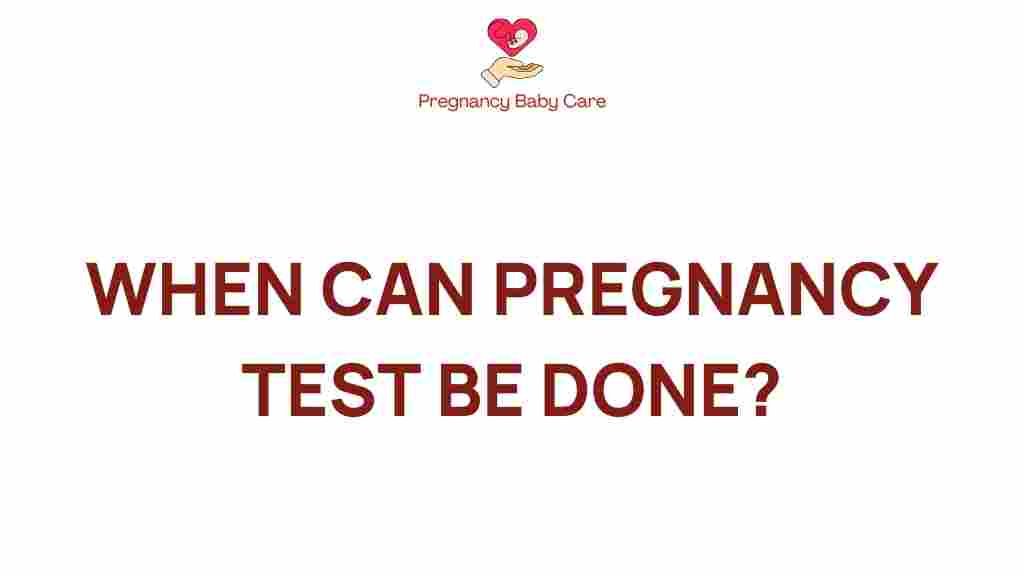Unlocking the Mystery: When Can a Pregnancy Test Be Done?
Understanding when to take a pregnancy test is crucial for those trying to conceive or suspecting they may be pregnant. Early detection can significantly impact prenatal care and planning. In this comprehensive guide, we will explore the timing, accuracy, and factors affecting the results of home pregnancy tests, along with the hormonal changes that signal conception. We will also discuss common pregnancy symptoms to look out for and how to effectively use these tests.
Understanding Pregnancy Tests
A pregnancy test is a medical device used to determine whether a woman is pregnant by detecting the presence of the hormone human chorionic gonadotropin (hCG) in her urine or blood. This hormone is produced shortly after a fertilized egg attaches to the uterine lining. Knowing when to use a pregnancy test is essential for achieving the best results.
Timing is Everything
Many women wonder, “When can I take a pregnancy test?” The answer depends on several factors, including:
- Ovulation Timing: Understanding your ovulation cycle is key. Ovulation typically occurs about 14 days before your next expected period.
- Conception: If you conceive shortly after ovulation, it can take several days for hCG levels to rise enough to be detected.
- Menstrual Cycle: The average menstrual cycle is about 28 days, but it can vary. Testing too early can lead to inaccurate results.
When to Test for Pregnancy
The best time to take a pregnancy test is:
- After a Missed Period: Most tests are designed to be taken on the first day of your missed period, as hCG levels are usually high enough to detect.
- One Week After Ovulation: For those tracking ovulation, testing one week after ovulation can yield reliable results.
- Early Tests: Some sensitive tests can detect pregnancy as early as 5 days before your missed period, but this may not be accurate for everyone.
How Home Pregnancy Tests Work
Home pregnancy tests are widely available and easy to use. Here’s how they work:
- Sample Collection: Most tests require a urine sample. It’s best to use the first morning urine, which contains the highest concentration of hCG.
- Testing: Follow the instructions provided with the test. Usually, you will dip a test strip into the urine or use a dropper to place urine on a test cassette.
- Results Interpretation: Wait the recommended time (usually a few minutes) to see the results. A positive result typically shows two lines or a plus sign, while a negative result shows one line or a minus sign.
Factors Affecting Accuracy
The accuracy of a pregnancy test can be influenced by several factors:
- Timing of the Test: Testing too early can lead to false negatives since hCG levels may not be high enough.
- Test Sensitivity: Different tests have different sensitivities to hCG. Some are designed for early detection, while others may not.
- Improper Use: Not following the instructions can result in inaccurate results.
- Hormonal Changes: Certain medical conditions can affect hCG levels and lead to misleading results.
Common Pregnancy Symptoms
In addition to using a pregnancy test, being aware of early pregnancy symptoms can provide additional context:
- Missed Period: The most obvious sign that you might be pregnant.
- Nausea: Often referred to as morning sickness, it can occur at any time of the day.
- Breast Changes: Tenderness, swelling, or changes in the areola may occur.
- Fatigue: Increased tiredness can be an early sign of pregnancy.
- Frequent Urination: Increased hormone levels can lead to more frequent bathroom trips.
Troubleshooting Tips
If you receive a negative result but still suspect you might be pregnant, consider the following troubleshooting tips:
- Wait a Few Days: If you tested early, wait a few days and test again.
- Check Expiration Date: Ensure that the test has not expired, as this can affect accuracy.
- Consult a Doctor: If you’re uncertain, a blood test at a healthcare provider can confirm pregnancy.
Conclusion
Understanding when and how to take a pregnancy test is essential for accurate results and peace of mind. By timing your test correctly, being aware of early pregnancy symptoms, and understanding the factors that affect test accuracy, you can unlock the mystery of your reproductive health. If in doubt, don’t hesitate to reach out to a healthcare professional for guidance.
For further reading on fertility and conception, check out this helpful resource. And for more information on home pregnancy tests and their effectiveness, visit this external link.
This article is in the category Pregnancy and created by PregnancyBabyCare Team
